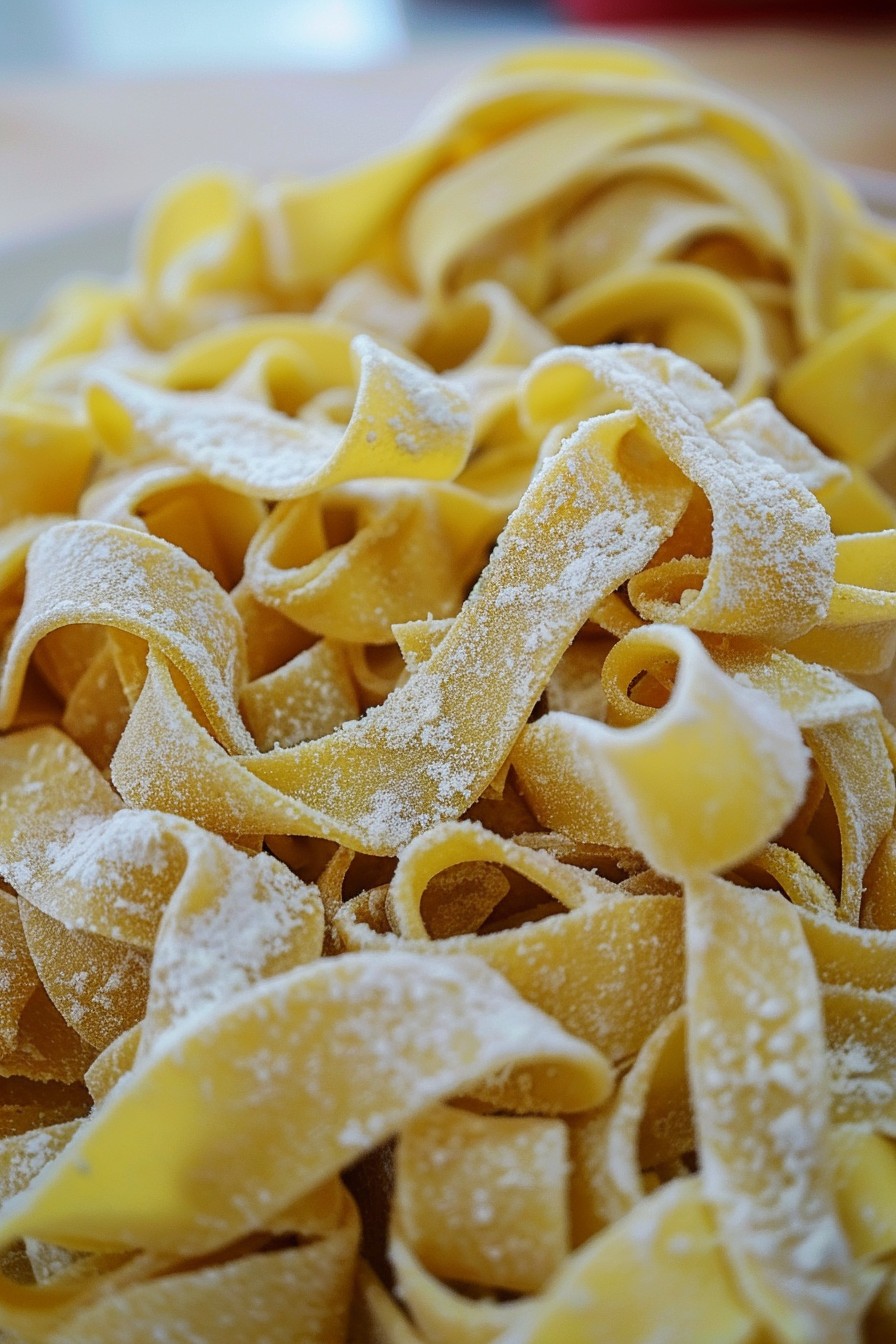There’s nothing quite like the taste of homemade pasta, and with this semolina recipe, you’ll be crafting pasta like a pro in no time. Trust me, once you go homemade, you’ll never look at store-bought the same way again.
Why This Recipe Works
- Semolina flour gives the pasta a delightful texture and golden color that’s hard to achieve with all-purpose flour alone.
- The simplicity of the ingredients lets the true flavor of the pasta shine through, making it the perfect canvas for any sauce.
- This recipe requires no fancy equipment, just your hands and a bit of elbow grease, making it accessible to everyone.
- It’s a versatile base that can be customized with herbs, spices, or even vegetable purees for a colorful twist.
- Making pasta from scratch is not only rewarding but also a fun way to impress your friends and family.
Ingredients
- 2 cups semolina flour
- 1/2 cup warm water (plus more if needed)
- 1/2 tsp salt
- 1 tbsp olive oil
Equipment Needed
- Large mixing bowl
- Wooden spoon
- Clean work surface
- Rolling pin
- Pasta cutter or knife
Instructions

Step 1: Mix the Dough
In a large mixing bowl, combine the semolina flour and salt. Make a well in the center and add the olive oil and warm water. Using a wooden spoon, gradually incorporate the flour into the liquid until a shaggy dough forms. If the dough feels too dry, add a tablespoon of water at a time until it comes together.
Step 2: Knead the Dough
Transfer the dough to a clean work surface and knead for about 10 minutes, or until the dough is smooth and elastic. If the dough sticks to your hands or the surface, dust with a little more semolina flour. The kneading process is crucial as it develops the gluten, giving your pasta that perfect al dente texture.
Step 3: Rest the Dough
Wrap the dough in plastic wrap and let it rest at room temperature for at least 30 minutes. This allows the gluten to relax, making the dough easier to roll out. Don’t skip this step, or you’ll end up with tough pasta.
Step 4: Roll Out the Dough
After resting, divide the dough into 4 equal parts. Working with one piece at a time, roll the dough out on a lightly floured surface until it’s about 1/8 inch thick. For thinner pasta, like tagliatelle, aim for 1/16 inch. Remember, the pasta will expand slightly when cooked, so roll it thinner than you think you need.
Step 5: Cut the Pasta
Using a pasta cutter or a sharp knife, cut the rolled-out dough into your desired shape. For fettuccine, cut strips about 1/4 inch wide. For pappardelle, go for 1 inch wide. Dust the cut pasta with semolina flour to prevent sticking and lay it out on a baking sheet until ready to cook.
Tips and Tricks
For those looking to elevate their pasta game, consider these advanced tips. First, if you’re making stuffed pasta like ravioli, ensure your filling is not too wet to prevent the pasta from becoming soggy. Second, experiment with adding flavors to your dough, such as spinach puree for green pasta or squid ink for a dramatic black hue. Lastly, for the best texture, cook your pasta in a large pot of boiling salted water and taste a piece a minute before the recommended cooking time to ensure it’s perfectly al dente.
Recipe Variations
- Herb-Infused Pasta: Add 2 tablespoons of finely chopped fresh herbs like basil, parsley, or thyme to the dough for a fragrant twist.
- Whole Wheat Pasta: Substitute half of the semolina flour with whole wheat flour for a nuttier flavor and extra fiber.
- Colorful Pasta: Incorporate vegetable purees, such as beetroot for red pasta or carrot for orange, to make your dish visually stunning.
- Spicy Pasta: Mix in 1 teaspoon of red pepper flakes for a kick that pairs wonderfully with creamy sauces.
- Cheesy Pasta: Stir in 1/4 cup of grated Parmesan or Pecorino Romano cheese into the dough for an extra layer of flavor.
Frequently Asked Questions
Can I make the dough without a stand mixer?
Absolutely! While a stand mixer with a dough hook can save you some elbow grease, this recipe is designed to be made by hand. The key is to knead the dough thoroughly until it’s smooth and elastic, which usually takes about 10 minutes. It’s a great workout, and there’s something therapeutic about hand-kneading dough.
How do I store homemade pasta?
If you’re not cooking the pasta immediately, you can dry it on a baking sheet for about an hour, then transfer it to an airtight container. It will keep at room temperature for a couple of days. For longer storage, freeze the pasta on a baking sheet before transferring to a freezer bag. It can be cooked directly from frozen, just add a minute or two to the cooking time.
Why is my pasta dough too sticky or too dry?
The consistency of your dough can vary based on humidity and the exact measurements of your ingredients. If it’s too sticky, add a little more semolina flour, a tablespoon at a time. If it’s too dry, sprinkle with water, also a tablespoon at a time, until it comes together. The dough should be smooth and pliable, not sticky or crumbly.
Summary
This homemade pasta semolina recipe is your ticket to creating delicious, authentic pasta with just a few simple ingredients. Whether you’re a beginner or a seasoned cook, the process is straightforward and the results are endlessly customizable. So roll up your sleeves and get ready to impress with your pasta-making skills!